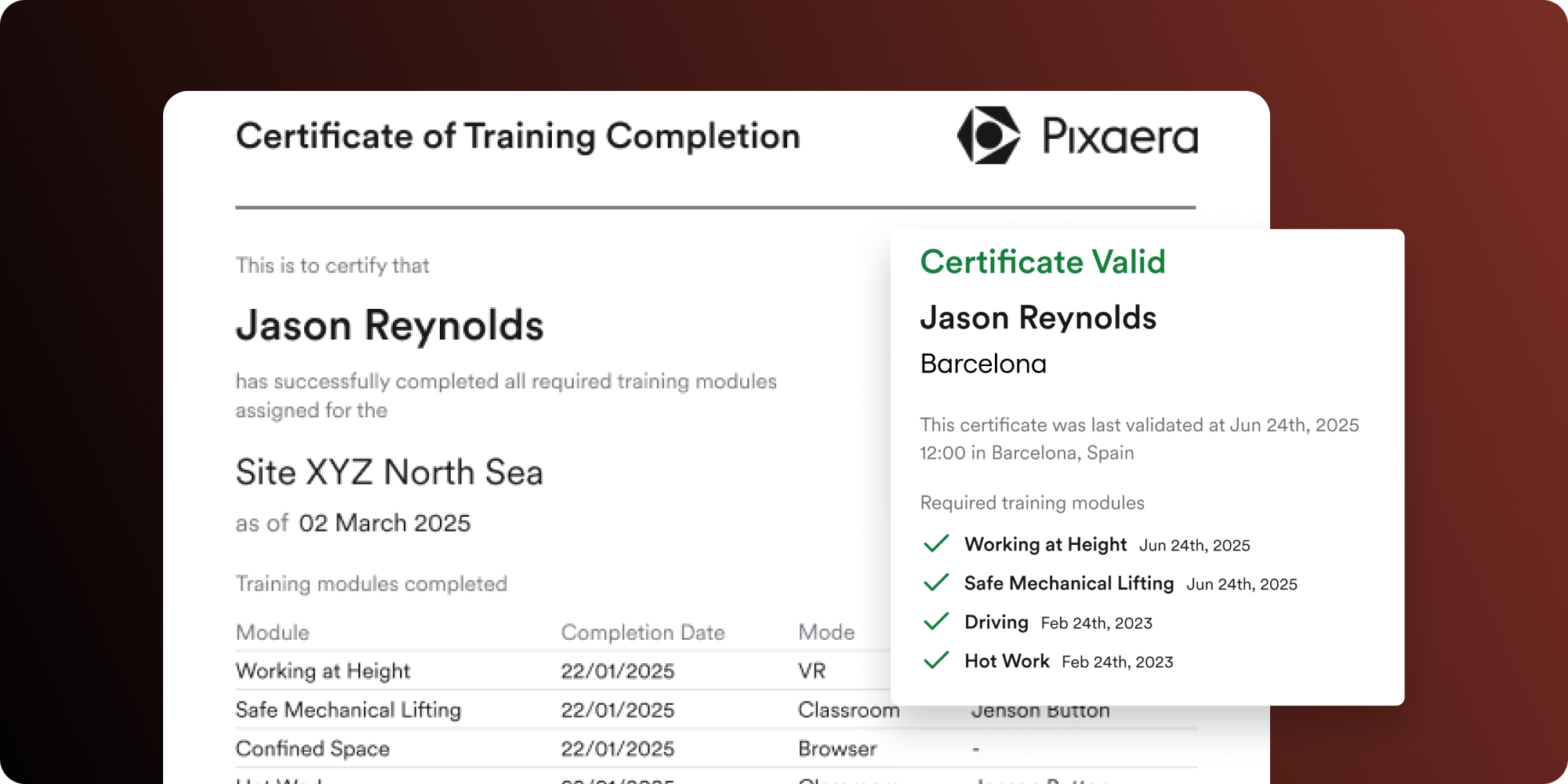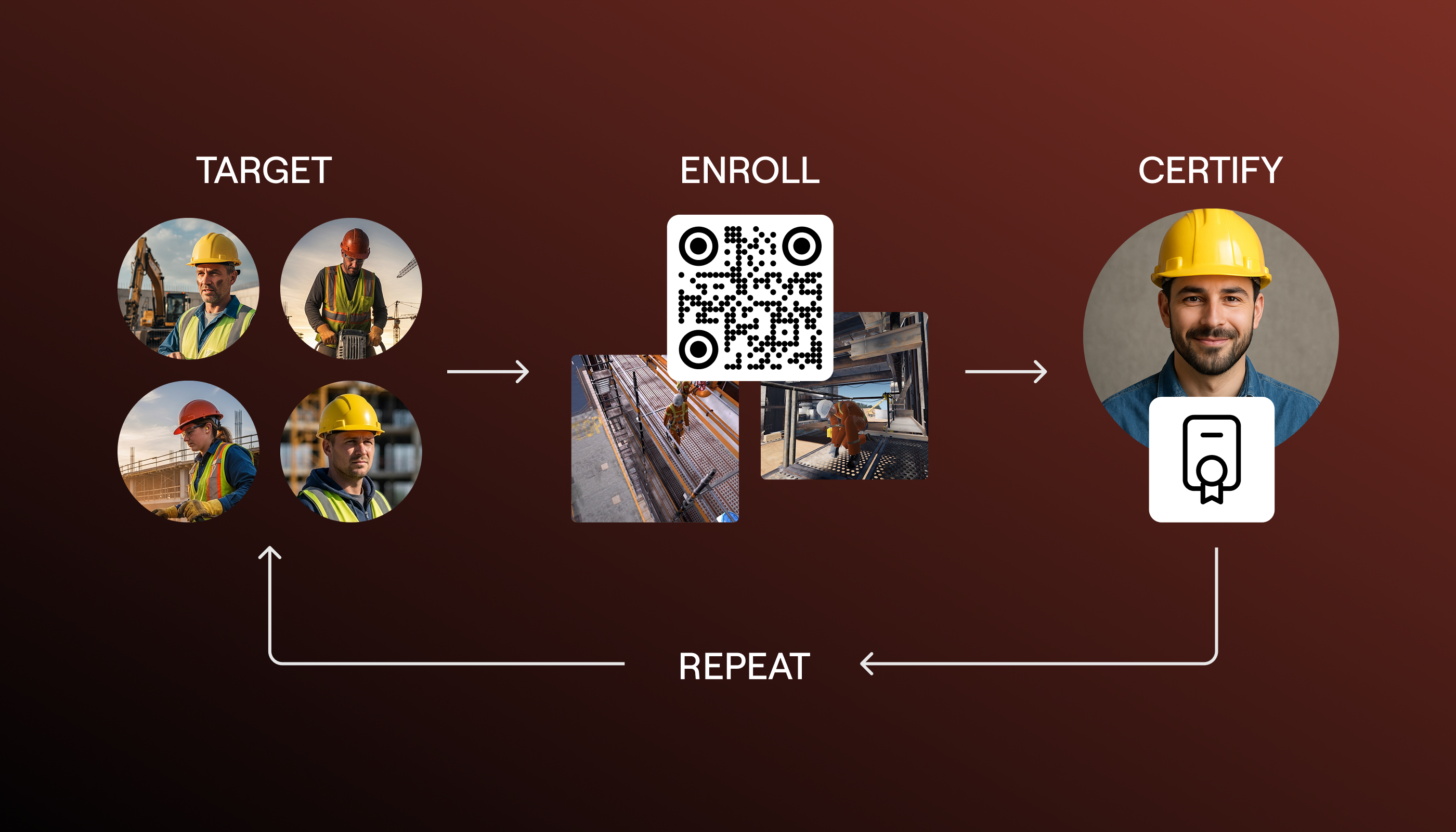From ad-hoc training to a repeatable compliance engine
Large workforces and rotating contractors don’t fail compliance because people don’t care — they fail because onboarding is fragmented. Spreadsheets, email threads, and last-minute site briefings create blind spots: the wrong workers take the wrong modules, certificates expire unnoticed, and supervisors become gatekeepers instead of enablers.
Today, Pixaera introduces a simple, repeatable flow that turns training from a scramble into a system.
Together, our three latest releases — Module assignment, Training access links, and Certificates of Completion — create a personalized, auditable training journey that scales across sites, regions, and contractor rotations. Let’s dive in ⬇️
What’s new
We’ve shipped three capabilities that work together so you can design a standard once and have it hold up across sites, roles, and rotating contractors.
Module assignment — align training to real work
How it works in Pixaera: Admins assign training modules to the right people by site, region, or group and set a validity period per module (e.g., 6/12/24 months). Assignments apply instantly to everyone in that configuration — and to anyone who is added to it later. In their Pixaera dashboard, workers only see the modules assigned to them. Each completion carries a timestamp – when a module expires, Pixaera nudges the worker to retrain. Because certificates are tied to assignments, the worker’s certificate becomes invalid until the refresher is completed. Validation in real time.
How you can use it: Pre‑assign requirements ahead of shutdowns; tailor by site and role; configure refresher cadence per module (and vary by site/role if needed); update centrally when procedures change; use consistent templates you can reuse across locations; keep contractors scoped to the work they’ll perform.
Why it matters: Removes noise that hides critical content and keeps skills current — not just completed. Automates requalification, reduces misassignment errors, and creates consistency so crews arrive safer and better prepared.

Coming soon: Training access links — self‑serve intake that places people correctly
How it works in Pixaera: Generate an invitation link scoped to a specific group/site/region. When a worker signs up through that link, Pixaera auto‑places them in the right group and immediately shows their required modules.
How you can use it: Share links in vendor packets or job‑award emails; post them in contractor portals; let vendors onboard rotating crews without spreadsheets or manual triage.
Why it matters: Cuts admin time, prevents placement mistakes, and gets people training before they travel — shortening day‑one delays.

Certificates of Completion — live proof workers are site‑ready
How it works in Pixaera: Admins enable an automated Certificate of Completion for the training configuration (assigned modules). When all required modules for trainee’s assignment are complete, Pixaera issues a certificate by email. Certificates stay in sync with assignments and expirations: if requirements change or a completion lapses, status flips to invalid until the gap is closed. Validation in real time.
How you can use it: Use certificates as auditable proof at check‑in and during inspections; know who’s valid versus not without manual tracking; rely on the system—not email chases—to surface what needs updating.
Why it matters: Shifts compliance from reactive checks to proactive enforcement, reduces gate queues, and keeps work moving without compromising safety.
Together, this becomes one motion you can run anywhere: design once, deploy everywhere.

How the workday changes
A week before an outage, Maya — an EHS lead overseeing multiple regions — opens Pixaera. She doesn’t build yet another slide deck. She sets the standard once: which modules apply to riggers at Site A, scaffolders at Site B, contractors entering confined spaces at Site C. That standard is expressed by role, site, region, or group, so it mirrors the real world.
Her contractor partners receive access links. Workers use the links to self-enroll; Pixaera places each person into the correct group automatically. When Rosa, a traveling rigger, signs in, she doesn’t face a catalog. She sees only the modules that matter to her.
Rosa completes high‑risk modules before she travels. When she finishes the required set, Pixaera issues a Certificate of Completion. That certificate is live: if requirements change or something expires mid‑job, the status flips to invalid until Rosa completes the update. At the gate, security and EHS can verify her status in real time — no spreadsheets, no guesswork, no last‑minute classroom detours.
Day one looks different: fewer idle hours, fewer rushed briefings, fewer opportunities for SIF exposure when people are distracted or overloaded. Work starts sooner — and safer.
Why this matters for your frontline
Generic training creates noise; noise creates blind spots. By aligning training to role, site, and task, you remove the clutter that causes workers to miss the few things that truly keep them safe. Clear, relevant modules completed before arrival lower first‑day exposure, reduce cognitive load, and help supervisors focus toolbox talks on the real risks of that job. And with per-module validity windows that trigger refreshers automatically, skills stay current — not just “completed once.”
Why this matters for the your organization
Safety that scales has to pay for itself. When crews train asynchronously and arrive site‑ready, you reclaim hours otherwise spent in rooms that don’t move the job forward. Access links replace manual sorting. Live certificates replace audit chases. A single standard rolls out across sites, so you don’t reinvent onboarding with every contractor rotation. Per-module validity and auto-retraining cut manual follow-ups and prevent lapsed qualifications. The result is fewer delays, fewer reworks, and a program finance can recognize in real numbers.
A quick scene from the field
Halfway through the outage, a near‑miss prompts a change: an amended lockout/tagout refresher is required for riggers. In the old world, that’s a scramble — emails, sign‑in sheets, and a lot of hope. In Pixaera, Maya updates the standard for riggers at Site A. Rosa’s certificate turns invalid; her dashboard shows a single, short module. She completes it at lunch. The certificate flips back to valid. Work resumes — safer, and without burning half a shift.
Making it real in your organization
Start small and design it to scale. Template the standard for one high‑risk role at one site. Share access links with a pilot vendor. Ask for pre‑arrival completion of the critical modules only. Use certificates as your single source of proof at the gate. Once you’ve validated the time‑to‑clear and incident‑prevention impact, roll the same pattern to additional contractor groups and sites — no reinvention required.
The takeaway
For EHS leaders, success is both human and operational: fewer injuries and SIFs, faster starts and demonstrable ROI. With Pixaera’s latest releases, you can set the standard once, then roll it out globally. Workers get the right training; you get real‑time proof — and the organization gets a safer, more predictable, more efficient start to every job.
Next step: Map your first role/site template with us. We’ll show you how to move from gate queues to site‑ready, certificate‑backed crews in a single pilot.
📩 Contact us | 🎙️ Listen to the Safety Heroes Podcast
Stronger, safer frontline teams start here!

